仁爱英语七年级下册Unit6 Topic 1 SectionB 教案设计
- 格式:doc
- 大小:31.50 KB
- 文档页数:3
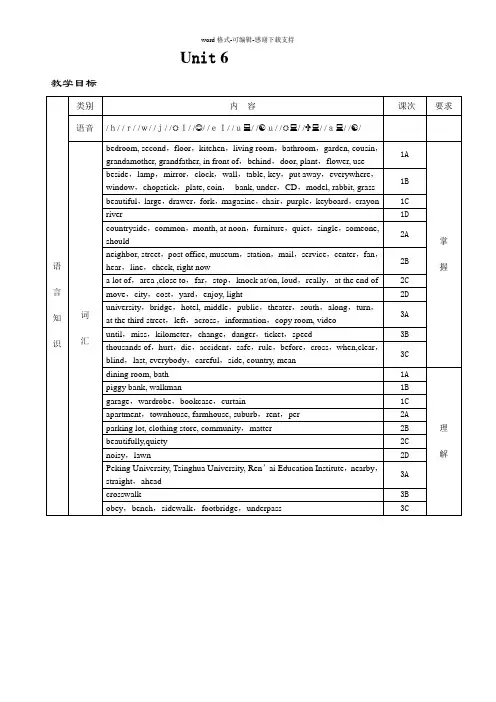
word格式-可编辑-感谢下载支持U nit 6教学目标word 格式-可编辑-感谢下载支持Topic 1 Section AThe main activities are 1a and 2a.本课重点活动是1a 和2a 。
Ⅰ. Teaching aims and demands 教学目标 1. Learn the rooms in homes :bedroom , kitchen ,dining room, living room, bathroom 2. (1)Learn the prepositions :in , on , next to , in front of , behind(2)Learn how to use the sentences of “there be ”: Is there a computer in your study? Yes , there is.Are there any bedrooms on the first floor? No , there aren ’t.1there be 句型There is a small garden in front of my house.There is a lamp , a mirror , a computer and some books on it. There are so many nice books on the shelf. Is there...? Yes , there is. /No , there isn ’t.Are there any...? Yes , there are./No , there aren ’t. How many...? There are... 2Wh- question Wh- 问题What ’s on the table? There are some keys on it. Where ’s the living room? It ’s on the first floor. 3表示方位的介词或副词on ,in ,at ,behind ,under ,in front of ,near ,across, from ,next to ,nearThere are so many nice books on the shelf. Ⅱ. Teaching aids 教具 录音机/挂图Ⅲ. Five-finger Teaching Plan 五指教学方案Step 1 Review 第一步 复习(时间:10分钟)1.(板书向学生呈现1a 挂图。
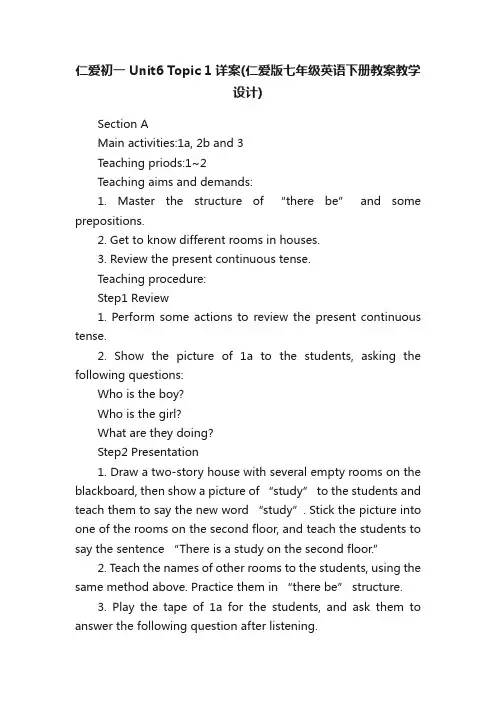
仁爱初一 Unit6 Topic 1 详案(仁爱版七年级英语下册教案教学设计)Section AMain activities:1a, 2b and 3Teaching priods:1~2Teaching aims and demands:1. Master the structure of “there be” and some prepositions.2. Get to know different rooms in houses.3. Review the present continuous tense.Teaching procedure:Step1 Review1. Perform some actions to review the present continuous tense.2. Show the picture of 1a to the students, asking the following questions:Who is the boy?Who is the girl?What are they doing?Step2 Presentation1. Draw a two-story house with several empty rooms on the blackboard, then show a picture of “study” to the students and teach them to say the new word “study”. Stick the picture into one of the rooms on the second floor, and teach the students to say the sentence “There is a study on the second floor.”2. Teach the names of other rooms to the students, using the same method above. Practice them in “there be” structure.3. Play the tape of 1a for the students, and ask them to answer the following question after listening.“Is there a computer in Jane’s study?”4. Go through the dialog with the students together, and deal with some language points.Write them down on the blackboard.Is there…Are there…Next to…Why not…Can I borrow…Step3 Consolidation1. Play the tape again and ask the students to follow it sentence by sentence, paying attention to the pronunciation and intonation.2. Get the students to practice and act out the dialog. Choose several pairs to act out in the front of the class.Step4 Practice1. Finish 2a and 2b in class.2. Review the present continuous tense.3. Practice 3.4. Choose several pairs to act out their dialog 3.Step5 Project1. Finish 4.2. Suppose a classmate or a friend is visiting your home. Make a dialog with your partner, using “there be” structure and the present continuous tense. List the following suggestion on the blackboard.There is…Is there…? Yes, there is./No, there isn’t.There a re…Are there …? Yes, there are./No, there aren’t.What’s on the first /second floor?What’s your mother/father …doing in the garden?He/she is V-ing…3. Choose several pairs to act out their dialog.Section BMain activities:1a and 3Teaching priods:1~2Teaching aims and demands:1. Learn more preposition of position in “there be” structure.2. Learn wh-question.3. Learn some home items.Teaching procedure:Step1 Review1. Review the main contents of Section A by brainstorming.For example:Does Jane have a nice house?Is there a garden beside he house?Where is the bedroom?2. GameDivide the class into two groups, and ask each group to speak out different rooms and prepositions they have learned one by one without long pause and repetition.Step2 Presentation1. Present the new words, using pictures or real objects.For example:Take out a mirror to teach the new word “mirror”, and put the mirror on the desk to teach the sentence “There is a mirror on the desk.”2. Teach the other home items and preposition, using thesame method above.3. Give the question: Who is playing with the computer? And then play the tape. Ask the students to answer the question after listening.4. Go through the dialog of 1a with the students, and list some key points on the blackboard and give necessary explanation, such as lamp, mirror and clock.Step3 Consolidation1. Play the tape of 1a again, and ask the students to follow it sentence by sentence, paying attention to the pronunciation and intonation.2. Get the students to practice the dialog in pairs, and then choose several pairs to act it out in class.3. Finish 2 in groups and check the answer together with the students. Give explanation if necessary.Step4 Practice1. Finish the rest part of 3 according to the example shown. Choose several pairs to act out their dialog.2. Look at the picture and finish 4.Step5 Project1. Suppose you’ve just moved into a new flat and need to buy many home items. Make a shopping list and then make up a short dialog about shopping. Act out your dialog with your partner in class.2. Classify the home items you have bought to see which items should be put into which room. List the items on the blackboard. Report your answer to the class.Section CMain activities:1a and 2Teaching priods:1Teaching aims and demands:1. Go on learning “there be” structure.2. Go on learning preposition of position.Teaching procedure:Step1 ReviewGuess a riddleThe teacher writes the first letter of a word on the blackboard, and gets the students to guess. Practice the first one whose guess is correct. If nobody can get he answer, the teacher can give some necessary English explanation.Step2 Presentation1. Ask the students to read 1a quickly and then finish the true or false questions.2. Do intensive reading again and ask the students to finish 1b alone. Check the answers in class and give necessary explanation.3. List some key words and sentences on the blackboard, and draw a stick figure on the blackboard. Retell the passage according to the key words and picture to show a model. Get the students to practice in pairs or groups.Step3 Consolidation1. Ask the students to finish 2 with the prepositions “in, on, under, behind, in front of” alone. Then check the answers in class and give necessary explanation.2. Ask the students to work in pairs to find the differences between the two pictures in3. Make a list of differences and then finish the blanks in pairs.Step4 Practice1. Find out the key words and sentences with the students. And then list them on the blackboard. The teacher gives a modelto retell the passage according to the key points, and then ask the students to retell the passage.For example:The curtain in Picture A, In Picture B, There is, In Picture, There is a bookcase, In the bookcase2. Sentence making game.List the following words on the blackboard.Step5 ProjectChain story.Make out a story in class. Everybody should try to make the story interesting and vivid.The teacher can begin the story like this:There is a beautiful girl in front of a big garden.Section DMain activities:1,4 and 5Teaching priods:1Teaching aims and demands:1. Review the main contents of Topic 1.2. Learn consonants.Teaching procedure:Step1 Review1. Use 3a and 3b as a clue to review the main contents of this topic.2. Share the story the students made during the last period.Step2 Presentation1. Put the words in 1 on the blackboard at random, ask the students to classify them according to the pronunciation, and ask them to read after the tape for several times.2. touching game-Hungry Shark1) Stick the following pictures at the bottom of theblackboard, and draw a picture like this:2) Divide the students into two groups and number each student in wither group so that there are two students who have the same number.3) Make enough room for running. The teacher speaks out a word first and then calls a number to see which student can touch the picture faster and correctly.4) The loser must come down one step from the stair.5) Call out different numbers and words faster and faster. The game is over when one group falls down into the mouth of the hungry shark.Step3 Consolidation1. Ask the students to finish the letter in 4 within a limited period, and ask one or two volunteers to read the letter in the front of the class.2. The rest of the class can ask questions according to the content of the letter.Step4 Practice1. Ask the students to draw a picture including the following words:a house, trees, a river, a yard, a boat, birds, a girl, a bridge, a dog, a lake2. Ask the students to describe their pictures orally, choose one or two volunteers to share their picture and passages with the class.Step5 ProjectFinish drawing the picture according to the cassette of 2.~。
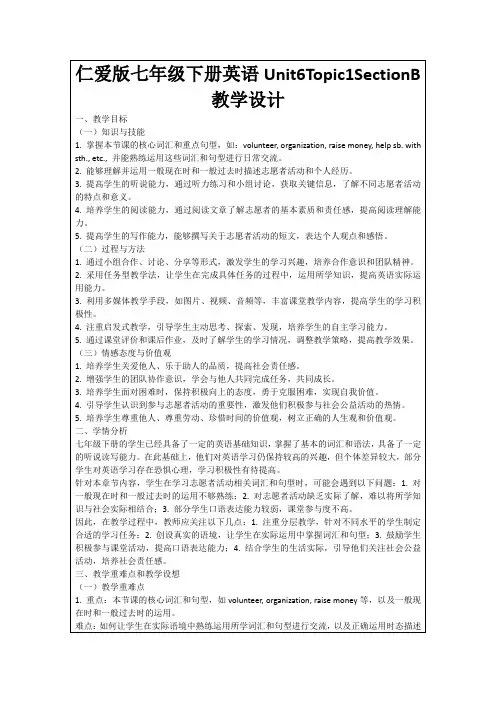
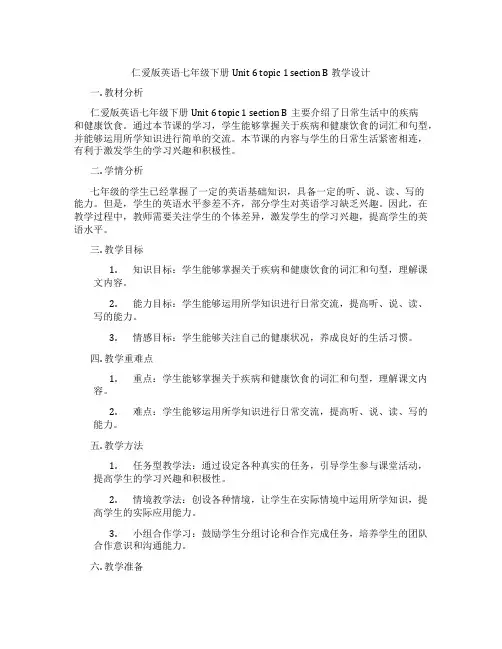
仁爱版英语七年级下册Unit 6 topic 1 section B 教学设计一. 教材分析仁爱版英语七年级下册Unit 6 topic 1 section B主要介绍了日常生活中的疾病和健康饮食。
通过本节课的学习,学生能够掌握关于疾病和健康饮食的词汇和句型,并能够运用所学知识进行简单的交流。
本节课的内容与学生的日常生活紧密相连,有利于激发学生的学习兴趣和积极性。
二. 学情分析七年级的学生已经掌握了一定的英语基础知识,具备一定的听、说、读、写的能力。
但是,学生的英语水平参差不齐,部分学生对英语学习缺乏兴趣。
因此,在教学过程中,教师需要关注学生的个体差异,激发学生的学习兴趣,提高学生的英语水平。
三. 教学目标1.知识目标:学生能够掌握关于疾病和健康饮食的词汇和句型,理解课文内容。
2.能力目标:学生能够运用所学知识进行日常交流,提高听、说、读、写的能力。
3.情感目标:学生能够关注自己的健康状况,养成良好的生活习惯。
四. 教学重难点1.重点:学生能够掌握关于疾病和健康饮食的词汇和句型,理解课文内容。
2.难点:学生能够运用所学知识进行日常交流,提高听、说、读、写的能力。
五. 教学方法1.任务型教学法:通过设定各种真实的任务,引导学生参与课堂活动,提高学生的学习兴趣和积极性。
2.情境教学法:创设各种情境,让学生在实际情境中运用所学知识,提高学生的实际应用能力。
3.小组合作学习:鼓励学生分组讨论和合作完成任务,培养学生的团队合作意识和沟通能力。
六. 教学准备1.教材:仁爱版英语七年级下册。
2.多媒体设备:电脑、投影仪、音响等。
3.教学资源:病句卡片、健康饮食图片等。
七. 教学过程1.导入(5分钟)教师通过向学生提问:“你们知道哪些疾病?你们平时是如何注意健康的?”引导学生谈论疾病和健康饮食,激发学生的学习兴趣。
2.呈现(5分钟)教师通过课件展示本节课的主要词汇和句型,如“I have a cold.”、“I have a stomachache.”等,并引导学生跟读。

Unit 6 Topic 1 Section A学习目标1. 学习本课中的新单词和词组。
2. 继续学习There be 句型并巩固运用。
3. 能够简单谈论自己的家。
自主学习一、预习Unit 6 Topic1 Section A 新单词(P127-128),然后根据所给中文写出对应的英文:1. 美丽的__________2. 花园____________3. 卧室____________4. 第二____________5. 楼层;地板_________6. 在(向)楼上_________7. 厨房___________ 8. 餐厅___________9. 客厅______________10. 浴室____________11. 第一_________ 12. 等等____________二、朗读1a,完成1b和1c。
根据所给中文,找出下列词组和短句,划线并翻译。
1.欢迎来到我的新家!_________________________2. 在二楼__________________________3. 挨着;在....旁边_________________4. 等等____________________________5. 上楼;到楼上去______________________6. 看一看________________________1a语法点拨1.--Where is your bedroom? --It’s on the second floor. There is a study next to my bedroom.你的卧室在哪儿?它在二楼,有一个书房紧挨着我的卧室。
(1)on the second floor “在二楼”,second 在此是序数词,意为“第二”,前面需要加定冠词the。
second 还可作名词,意为“秒”,表时间。
(2)study 在此是名词,意为“书房”,复数形式为studies。
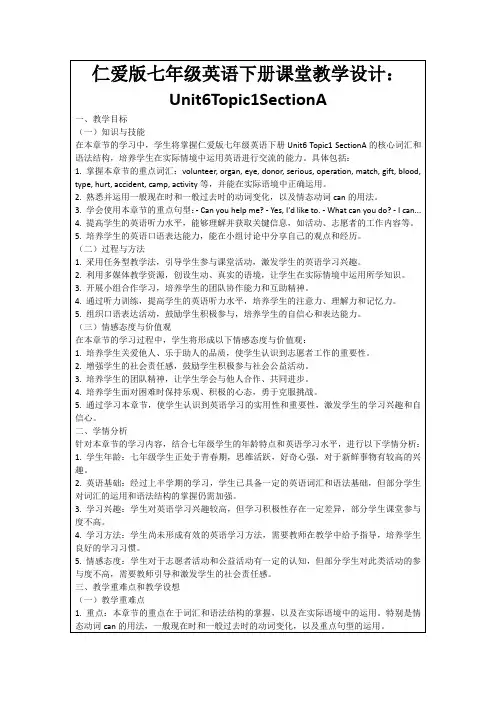
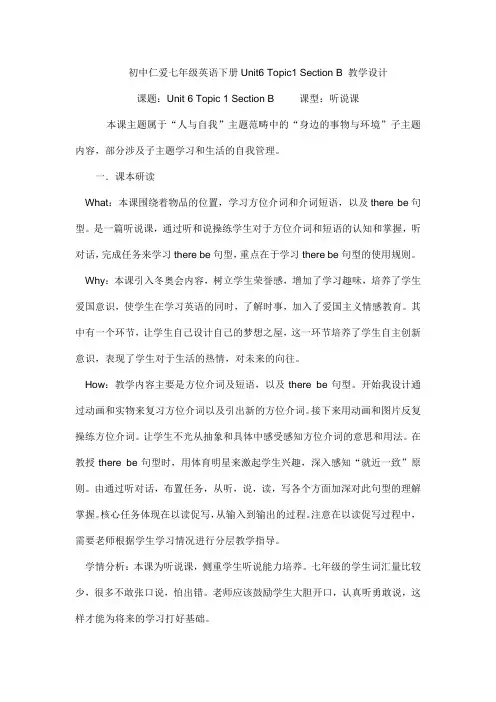
初中仁爱七年级英语下册Unit6 Topic1 Section B 教学设计课题:Unit 6 Topic 1 Section B 课型:听说课本课主题属于“人与自我”主题范畴中的“身边的事物与环境”子主题内容,部分涉及子主题学习和生活的自我管理。
一.课本研读What:本课围绕着物品的位置,学习方位介词和介词短语,以及there be句型。
是一篇听说课,通过听和说操练学生对于方位介词和短语的认知和掌握,听对话,完成任务来学习there be句型,重点在于学习there be句型的使用规则。
Why:本课引入冬奥会内容,树立学生荣誉感,增加了学习趣味,培养了学生爱国意识,使学生在学习英语的同时,了解时事,加入了爱国主义情感教育。
其中有一个环节,让学生自己设计自己的梦想之屋,这一环节培养了学生自主创新意识,表现了学生对于生活的热情,对未来的向往。
How:教学内容主要是方位介词及短语,以及there be句型。
开始我设计通过动画和实物来复习方位介词以及引出新的方位介词。
接下来用动画和图片反复操练方位介词。
让学生不光从抽象和具体中感受感知方位介词的意思和用法。
在教授there be句型时,用体育明星来激起学生兴趣,深入感知“就近一致”原则。
由通过听对话,布置任务,从听,说,读,写各个方面加深对此句型的理解掌握。
核心任务体现在以读促写,从输入到输出的过程。
注意在以读促写过程中,需要老师根据学生学习情况进行分层教学指导。
学情分析:本课为听说课,侧重学生听说能力培养。
七年级的学生词汇量比较少,很多不敢张口说,怕出错。
老师应该鼓励学生大胆开口,认真听勇敢说,这样才能为将来的学习打好基础。
学习反思:我上的这节课主要是学习there be句型以及方位介词:in front of,in the front of,near等方位介词词组的用法。
掌握这些短语和句型并不难,但对于基础薄弱的学生来说,如何让他们学得更轻松,更扎实就成为我这节课课堂设计的一个重点。
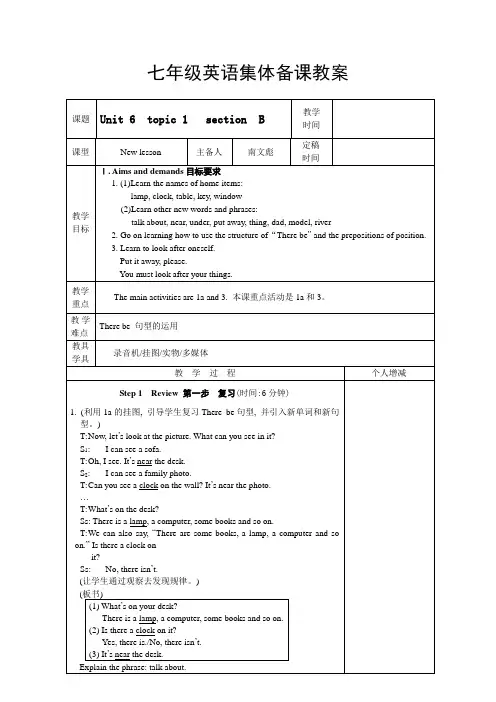
七年级英语集体备课教案板书设计教学反思随堂练习单项选择( ) 1.—Where are my keys, Dad? I can’t find them.—Look! They’re under the table. You must _____ .A.put it awayB.put away itC.put them awayD.put away them( ) 2.Excuse me, can you tell me _____ Xinhua Bookstore?A.the way toB.the wayC.the road toD.the road( ) 3.—Excuse me, may I speak to Linda?—_____A.Sorry, I don’t know you.B.Who are you?C.Is that Linda?D.This is Linda speaking.( ) 4.—Excuse me, _____ is it from here to Zhongshan Park?—It’s about seven kilometers.A.how longB.how oftenC.how farD.how much( ) 5.Listen, one of the _____ singing in Japanese.A.girl isB.girls areC.girl areD.girls is巩固练习根据对话的情景,从方框中选择适当的句子填在画线处,使对话完整通顺。
其中有两项是多余的。
A: Excuse me. 21B: Go down this street, turn right and walk on until you get to the end.22 It’s between the post office and the food shop.A: 23B: It’s about seven kilometers from here.24A: Which bus do I need to take?B: First, you need to take bus No. 651, then you should change to the No.426 bus at Yongding Bridge. 25A: Thank you very much.B: You are welcome!。
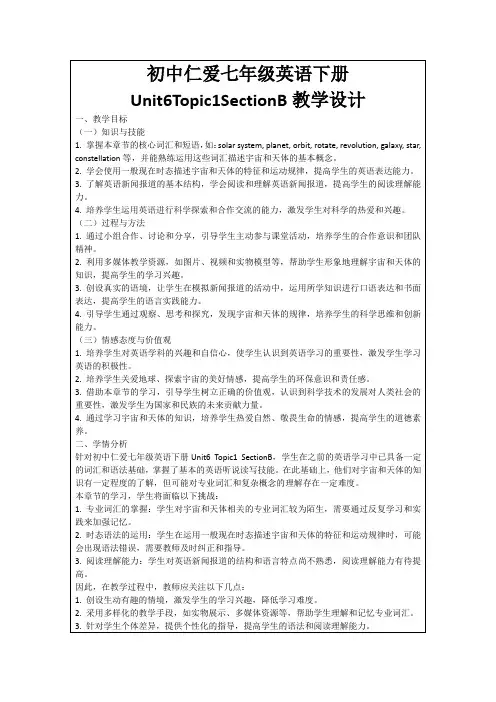
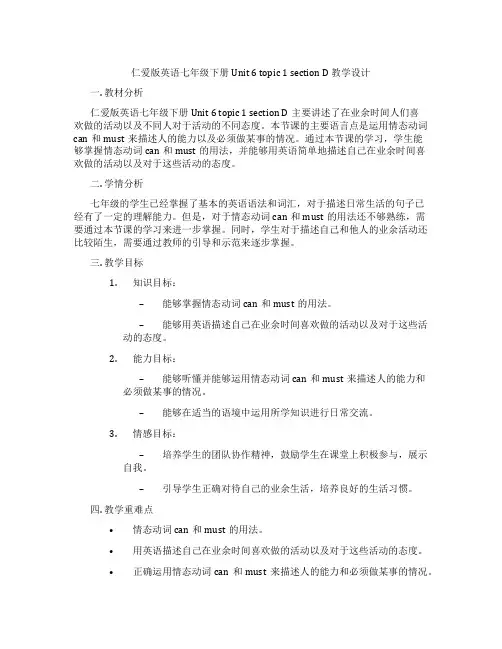
仁爱版英语七年级下册Unit 6 topic 1 section D 教学设计一. 教材分析仁爱版英语七年级下册Unit 6 topic 1 section D主要讲述了在业余时间人们喜欢做的活动以及不同人对于活动的不同态度。
本节课的主要语言点是运用情态动词can和must来描述人的能力以及必须做某事的情况。
通过本节课的学习,学生能够掌握情态动词can和must的用法,并能够用英语简单地描述自己在业余时间喜欢做的活动以及对于这些活动的态度。
二. 学情分析七年级的学生已经掌握了基本的英语语法和词汇,对于描述日常生活的句子已经有了一定的理解能力。
但是,对于情态动词can和must的用法还不够熟练,需要通过本节课的学习来进一步掌握。
同时,学生对于描述自己和他人的业余活动还比较陌生,需要通过教师的引导和示范来逐步掌握。
三. 教学目标1.知识目标:–能够掌握情态动词can和must的用法。
–能够用英语描述自己在业余时间喜欢做的活动以及对于这些活动的态度。
2.能力目标:–能够听懂并能够运用情态动词can和must来描述人的能力和必须做某事的情况。
–能够在适当的语境中运用所学知识进行日常交流。
3.情感目标:–培养学生的团队协作精神,鼓励学生在课堂上积极参与,展示自我。
–引导学生正确对待自己的业余生活,培养良好的生活习惯。
四. 教学重难点•情态动词can和must的用法。
•用英语描述自己在业余时间喜欢做的活动以及对于这些活动的态度。
•正确运用情态动词can和must来描述人的能力和必须做某事的情况。
•在适当的语境中运用所学知识进行日常交流。
五. 教学方法1.情境教学法:通过设定日常生活的情境,让学生在实际语境中学习并运用情态动词can和must。
2.交际法:通过小组讨论和角色扮演等方式,让学生在实际交流中运用所学知识。
3.任务型教学法:通过完成各种任务,让学生在实践中掌握情态动词can和must的用法。
六. 教学准备1.教学材料:教材、PPT、黑板、粉笔。
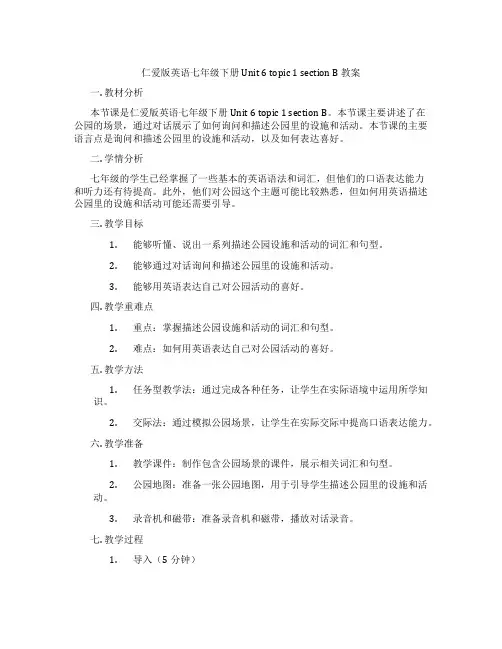
仁爱版英语七年级下册Unit 6 topic 1 section B 教案一. 教材分析本节课是仁爱版英语七年级下册Unit 6 topic 1 section B。
本节课主要讲述了在公园的场景,通过对话展示了如何询问和描述公园里的设施和活动。
本节课的主要语言点是询问和描述公园里的设施和活动,以及如何表达喜好。
二. 学情分析七年级的学生已经掌握了一些基本的英语语法和词汇,但他们的口语表达能力和听力还有待提高。
此外,他们对公园这个主题可能比较熟悉,但如何用英语描述公园里的设施和活动可能还需要引导。
三. 教学目标1.能够听懂、说出一系列描述公园设施和活动的词汇和句型。
2.能够通过对话询问和描述公园里的设施和活动。
3.能够用英语表达自己对公园活动的喜好。
四. 教学重难点1.重点:掌握描述公园设施和活动的词汇和句型。
2.难点:如何用英语表达自己对公园活动的喜好。
五. 教学方法1.任务型教学法:通过完成各种任务,让学生在实际语境中运用所学知识。
2.交际法:通过模拟公园场景,让学生在实际交际中提高口语表达能力。
六. 教学准备1.教学课件:制作包含公园场景的课件,展示相关词汇和句型。
2.公园地图:准备一张公园地图,用于引导学生描述公园里的设施和活动。
3.录音机和磁带:准备录音机和磁带,播放对话录音。
七. 教学过程1.导入(5分钟)利用课件展示公园的美景,引导学生谈论他们对公园的喜好。
例如:“Do you like parks? Why?”2.呈现(10分钟)展示公园地图,引导学生观察公园里的设施和活动。
然后,展示对话录音,让学生听懂对话内容。
3.操练(15分钟)学生分组,模拟公园场景,用英语进行对话。
教师巡回指导,纠正学生的错误,并给予鼓励。
4.巩固(5分钟)教师选取几组学生的对话,进行展示和评价。
同时,引导学生用英语描述自己喜欢的公园活动。
5.拓展(5分钟)邀请学生分享他们去公园的经历,用英语描述公园里的设施和活动。
仁爱版英语七年级下册Unit 6 topic 1 section A 教学设计一. 教材分析仁爱版英语七年级下册Unit 6 topic 1 section A主要讲述了一对兄妹David和Sarah在周末的计划。
本节课的主要内容是让学生掌握一般将来时态的构成和用法,以及如何用英语描述周末计划。
教材通过真实的语境,引导学生学会用英语进行日常交流,培养他们的语言运用能力。
二. 学情分析七年级的学生已经学习了一般现在时态和一般过去时态,对英语学习有了一定的基础。
但部分学生可能对一般将来时态的构成和用法还不够熟悉,需要老师在教学中进行引导和巩固。
此外,学生们的口语表达能力参差不齐,需要在课堂操练环节给予充分的练习和鼓励。
三. 教学目标1.知识目标:–能正确运用一般将来时态描述周末计划。
–能听懂、会说、会读本节课的重点词汇和句型。
2.能力目标:–能用英语进行简单的日常交流,提高口语表达能力。
–能通过小组合作,完成对话任务,提高团队协作能力。
3.情感目标:–培养学生的学习兴趣,激发他们学习英语的积极性。
–培养学生的团队精神,提高他们的人际沟通能力。
四. 教学重难点•一般将来时态的构成和用法。
•本节课的重点词汇和句型。
•一般将来时态的运用,尤其是在描述具体情境时的运用。
•学生口语表达能力的提高,尤其是对于时态的准确运用。
五. 教学方法1.情境教学法:通过设置真实的生活情境,让学生在实际语境中学习英语,提高他们的语言运用能力。
2.任务型教学法:通过小组合作完成任务,激发学生的学习兴趣,培养他们的团队协作能力。
3.交际法:注重师生互动,生生互动,提高学生的口语表达能力。
六. 教学准备1.教学课件:制作课件,包括本节课的重点词汇、句型和情境对话。
2.教学道具:准备与本节课相关的生活用品,如图片、卡片等。
3.听力材料:准备与本节课相关的听力材料,以便进行听力训练。
七. 教学过程1.导入(5分钟)–老师与学生进行简单的英语交流,复习一下之前学过的一般现在时态和一般过去时态。
七下Unit 6 Our Local AreaTopic 1 Is there a clock on your desk? Section ASection A needs 1~2 periods. Section A 需用1~2课时。
The main activities are 1a, 2a and 3. 本课重点活动是1a,2a和3。
Ⅰ. Aims and demands目标要求1. (1)Learn the words of rooms in homes: bedroom, kitchen, dining room, living room, bathroom(2)Learn other new words and phrases: garden, second, floor, upstairs, come in, house, grandfather, door2. (1)Learn some prepositions of position: in, on, next to, in front of, behind(2)Learn the structure of“There be”.Oh, there are so many books on the shelves.Is there a computer in your study? Yes, there is. Are there any books in the study? Yes, there are. Ⅱ. Teaching aids 教具录音机/挂图/单词卡片Ⅲ. Five-finger Teaching Plan 五指教学方案Step 1 Review 第一步复习(时间:5分钟)复习现在进行时和一般现在时,引出1a中的新词汇。
(方案一) (老师在黑板上画一幅简笔画,让学生看图回答问题。
)T: Boys and girls. What’s Nancy doing?Ss: She is reading.T: Where is she reading now, do you know?Ss: In the study.T: Yes. She is reading in the study.(We usually read in the study.教师边说边在黑板的左上方并排写出“read, in the study”,教师继续问学生Then do you want to know where I sleep/cook/eat/watch TV…?引导学生向教师发问。
Unit6 Topic1Is there a clock on your desk?
Section B
一、T eaching aims(教学目标)
1.继续学习“There is/are"表示”存在有“这一句型。
2.继续学习方位介词,如near,on,under等。
3. 掌握单词lamp, clock, table, key, window,并学会保管好自己的物品。
二、Main points(学习重点)
1.“There is/are"表示”存在有“句型。
2.方位介词,near,on,under,behind
三、Difficult points(学习难点)
方位介词near,on,under,behind的使用
四、T eaching procedure(教学过程)
阅读课本125--126页单词以及107页课文注释,然后完成下列练习。
课前预习:根据汉语意思完成下列句子。
1.Listen!Some birds are singing ____ ____ ___(在树上).
---What's on the table?
2. - --There is a computer____ _____(紧挨着)the lamp on it.
3.Don't put your books on the bed. _____ them _____(收好),please.
4.--Where is my soccer?
----It's ______ ______ _______(在桌下).
5.The boy is playing with a _______ ______(飞机模型).
Step1:学习125-126页的新单词。
Step2:听读第27页1a的内容,然后分析课文。
1.There is /are 表示“存在有”eg:There is a book on the desk. 桌子上有一本书。
There are seven days in a week. 一个星期有七天。
2.What's on your desk? 你书桌上有什么?What's + 介词这个句型用来询问某处有什么,回答用“There is /are.....”
Eg: What's on your desk? --- There is a book on it.
3.介词near 在。
附近,旁边;on 在。
上面;under 在。
下面;behind 在。
后面
4.talk about 谈论...; put away “将...收起”
Step3:根据1a,完成2的work alone活动。
Step4:阅读28页3 pair work,仿照例句操练图片上的内容。
五、随堂练习
1.( ) What are the boys doing?
----They're ____ the soccer games over there.
A.talking to
B. talking about
C. talking with
2.---Is there an old man near the house ?
---_____
A.Y es, it is.
B. Y es , it does.
C. Y es, there is.
3.--How many_____ are there in your class?
---There is only one.
B.clocks B. a clock
C. clock
4.--Dad, what____ in the desk?
---There are some books and a pencil-box.
A.are
B. Is
C./
句型转换
1.There are seven days in a week?(对划线进行提问)
_____ _____ days are there in a week?
2.My shoes are under the bed.(对划线进行提问)
_____ ______ your shoes ?
3.I have a TV set in the living room.(同义句转换)
______ _____ a TV set in _____ living room.
4.There is a book on the table near the window.(对划线进行提问)_____ on the table near the window?
六、作业
a.背诵书本第27页1a 中对话
b.预习书本第29页section c
七、教学反思。